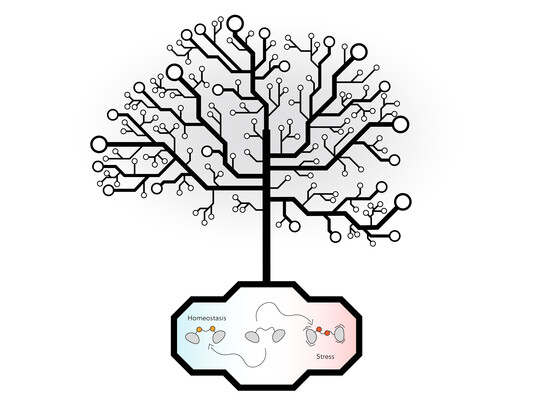Autophagy: The molecular regulation of self-eating
Persistent cellular stress, resulting from disturbances of cellular homeostasis, impairs cell fitness and lifespan. Cellular stress may develop, for example, when ribosomes collide while translating faulty mRNAs. As a result, cells get overburdened with unfinished and improperly formed protein products that form toxic protein aggregates. During cellular stress, cells can call on an arsenal of quality control (QC) mechanisms to restore homeostasis. Cells experiencing prolonged stress in the endoplasmic reticulum (ER), the cellular center for protein synthesis and transport, initiate an ER-specific autophagic pathway called “ER-phagy” to selectively remove damaged ER. When ribosomes collide on the ER, another QC pathway, called “UFMylation”, cooperates with ER-phagy to get rid of incompletely synthesized proteins at the ER membrane. UFMylation is an enigmatic QC pathway based on a protein post-translational modification that resembles ubiquitin and its functions are still being deciphered.
Now, a team of researchers at the Vienna BioCenter uncover an ancient molecular switch that regulates ER-phagy. Using a combination of evolutionary biology and mechanistic experimentation, the researchers demonstrate that the competition between two ubiquitin-like molecules, UFM1 and ATG8 creates a molecular switch in the master regulator C53, thus initiating ER-phagy.
“Our previous work suggested that C53 could link the two quality control mechanisms, ER-phagy and UFMylation. However, the molecular nature of this bridge remained unclear,” says the co-corresponding author and GMI group leader Yasin Dagdas. In the work in question, published in 2020, the scientists showed that C53 interacted with the protein ATG8, a ubiquitin-like player in the autophagy pathway, through non-canonical ATG8 Interacting Motif (AIM) sequences in C53’s intrinsically disordered region. The researchers named these non-canonical AIMs “shuffled AIMs” (sAIMs). They also demonstrated that UFM1, the ubiquitin-like molecule that is attached as a chemical modification to protein substrates, competes with ATG8 for C53 binding. The C53 intrinsically disordered region contains three sAIM motifs and one canonical AIM (cAIM). “Now, using Nuclear Magnetic Resonance spectroscopy, we showed that C53 sAIM1 and sAIM2 were UFM1’s preferred binding motifs. On the other hand, ATG8 had a considerably higher preference for the cAIM motif on C53, as expected for a canonical binding sequence. Yet, ATG8 also interacted with sAIM1 and sAIM2, albeit with a lesser affinity,” says Elif Karagöz, co-corresponding author and Max Perutz Labs group leader.
Having uncovered the binding preferences of UFM1 and ATG8 in the intrinsically disordered region of C53, the team sought to test their function by substituting the sAIM motifs in C53 with canonical cAIM sequences. By introducing these mutations in Arabidopsis thaliana, the researchers effectively strengthened the binding affinity of ATG8 to C53 and impaired UFM1’s binding. This led to constant firing through the C53 autophagy pathway and greatly sensitized the plants to ER stress. Thus, the team demonstrated that sAIMs are essential for regulating C53-mediated ER-phagy and thereby ER stress tolerance.
The team analyzed the evolutionary path of C53, sAIMs, and UFMylation components with the help of Thomas A. Richards’ lab at the University of Oxford. They demonstrated that C53-mediated autophagy was conserved among eukaryotes and that C53 co-evolved with the UFMylation pathway. Molecular remnants or the existence of related proteins indicated that fungi, some algae, and some eukaryotic parasites were subject to a secondary loss of UFMylation and/or C53. “Our results show that C53 is very much linked to UFMylation, suggesting a highly conserved functional link. This applies to sAIMs in particular: In species that have lost UFM1, their C53 also lost its sAIMs,” says Dagdas.
With the help of Silvia Ramundo’s lab at GMI, the researchers went further and demonstrated that the unicellular algae Chlamydomonas reinhardtii possesses a functional UFMylation pathway. This finding counters previous claims that the UFMylation pathway was linked to the evolution of multicellularity.
“Taken together, our findings indicate that the non-canonical ATG8 interacting motifs evolved to allow another ubiquitin-like protein, UFM1, to bind C53 and keep it inactive under homeostatic conditions,” says Dagdas. This mechanism is essential to prevent cells from “eating” healthy cellular components.
Finally, seeing as fungi and some eukaryotic parasites have lost the UFMylation pathway at a more recent time in evolution, Dagdas believes that these organisms must have evolved analogous mechanisms to fulfill the same function, namely maintaining ER homeostasis. “Identifying such mechanisms in fungi, but also in parasites affecting plants, animals, and even humans would open up potential translational avenues for new drugs,” concludes Dagdas.

